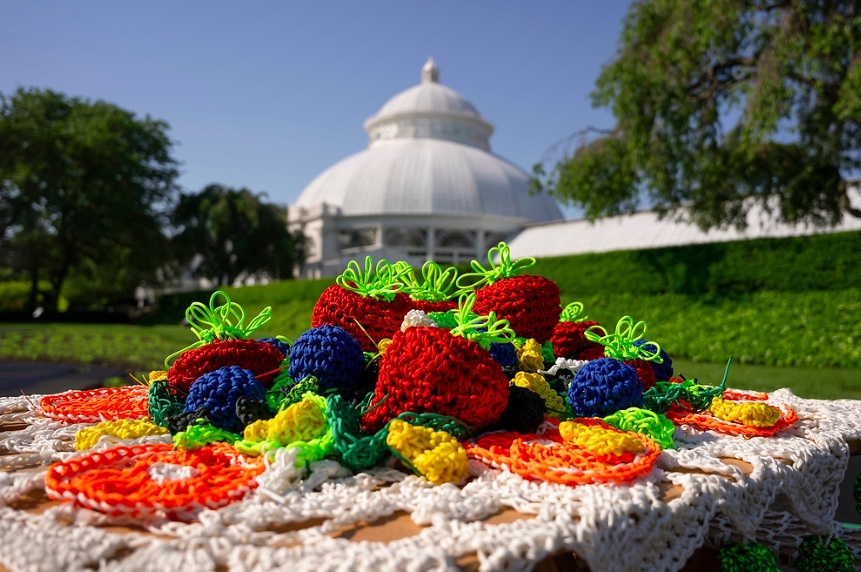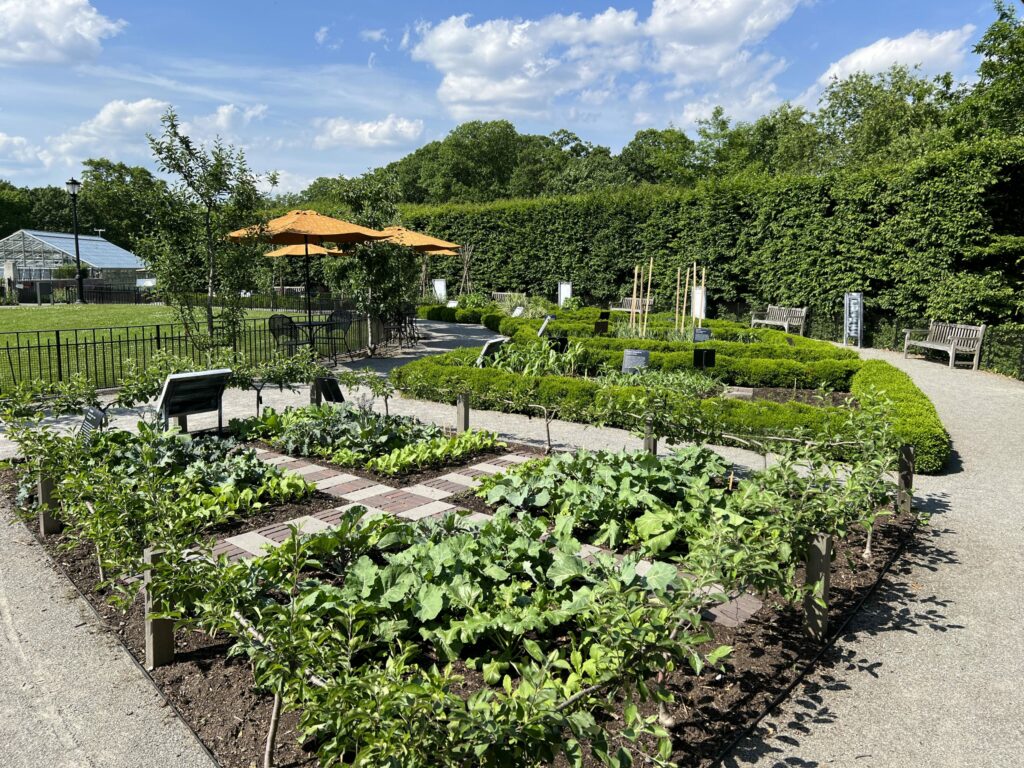he New York Botanical Garden’s major, institution-wide exhibition Around the Table: Stories of the Foods We Love examines the art and science of foodways and food traditions, many dating back thousands of years. Visitors can explore the rich cultural history of what we eat and learn that—from global dietary staples such as rice, beans, squash, and corn to the regional spice and flavor provided by peppers, greens, and tomatoes—plants are at the base of all culinary customs. The presentation features expansive displays of living edible plants; art and science installations; weekend celebrations; wellness, culinary-themed, and children’s programming; and opportunities to gather at artist-designed tables set throughout NYBG’s 250 acres, bringing to life stories about the featured and other notable edible plants. Around the Table: Stories of the Foods We Love is on view June 4 through September 11, 2022.

Displays of Living Edible Plants at the Enid A. Haupt Conservatory
Showcasing hundreds of varieties of edible plants, including peppers, squash, cabbage, beans, grains, corn, banana, sugarcane, taro, and breadfruit, three installations in and around the Haupt Conservatory beckon visitors to explore the diversity and beauty of food plants grown around the world.
- In the Conservatory’s Seasonal Exhibition Galleries, a wide assortment of edible herbaceous plants and fruit-bearing trees flourishing in containers, entwined in overhead trellises, and reaching skyward from green walls ideal for compact urban spaces inspire appreciation of the plants that nourish us.
- The Conservatory Courtyards offer an array of familiar and surprising edible plants from across the globe—from dietary staples of the tropical regions of the world, including rice, taro, and banana, to crops suited to arid regions of the globe, including figs, citrus, and pearl millet. Peppers and tomatoes and other nightshades, grapes and olives, a gourd trellis, and a spirits garden featuring plants used in the creation of beer, wine, and liquors round out this diverse display.
- A portion of the Botanical Garden’s Conservatory Lawn is transformed into an undulating field of dwarf sorghum and barley, traditional grains well-suited to NYBG’s climate, allowing observation of the sowing, nurturing, harvesting, and replanting processes of these foundational food plants over the course of the exhibition.

African American Garden at the Edible Academy
Curated by Dr. Jessica B. Harris, America’s leading scholar on the foods of the African Diaspora, African American Garden: Remembrance & Resilience celebrates African American food and gardening histories and the contributions of essential plants to American foodways. Dr. Harris has worked with historians, heritage seed collectors, and NYBG’s Edible Academy staff to present a sequence of eight garden beds arranged in a semi-circle that celebrate African American food and gardening histories and their ongoing contributions to America’s plant and food culture. The experience also includes an orientation center, shaded seating areas, and a Hibiscus Drink Station designed by scenic designer Lawrence E. Moten III, whose include Broadway’s Chicken & Biscuits. The African American Garden also features a Poetry Walk curated by Cave Canem Foundation, the premier home for Black poetry, committed to cultivating the artistic and professional growth of African American poets.
Art and Science Installations Throughout the Garden
After a call for artists that resulted in many impressive submissions, The New York Botanical Garden selected 30 local artists, living or working in the Bronx, to design and create tables that explore central themes from Around the Table. On display across the Botanical Garden’s 250 acres, the artist-designed tables incorporate notable food plants, highlighting the plants’ history and cultural significance as well personal stories of food traditions and celebrations. The tables and accompanying interpretation encourage sitting, sharing, and storytelling. Visitors are prompted to learn more via the Bloomberg Connects mobile application, and at select tables, to create artworks or tell their own food stories.

In the LuEsther T. Mertz Library Building Art Gallery, visitors can examine the social and cultural impacts of the American food system through displayed works by contemporary Colombian-American artist Lina Puerta in Lina Puerta: Accumulated Wisdom. Puerta celebrates and acknowledges the essential, often invisible, role of farmworkers, the relationship between nature and the human-made, and ancestral knowledge in mixed-media sculptures, installations, collages, hand-made paper paintings, and wall hangings that incorporate materials ranging from textiles and handmade paper to found, personal, and recycled objects.
Launched in 2021, NYBG’s Bronx Foodways Oral Histories Project is a multiyear effort to collect, record, and archive personal food narratives from Bronx urban farmers and gardeners who focus on community gardens as centers for food, heritage, community, and social justice—making them accessible to the public. Each year, The New York Botanical Garden commissions two public murals celebrating the gardens and farmers from the Oral Histories Project. As part of the Around the Table exhibition, celebrated Bronx-based artist André Trenier is creating the initial murals. In NYBG’s Arthur and Janet Ross Gallery, . . .la tierra es nuestro alimento/the land is our nourishment presents oral history videos and photos of Bronx gardens taken by students from the Bronx Documentary Center as well as highlights Trenier’s murals.
Also in the Mertz Library Building, the creativity and ingenuity of plant scientists and plant-based chefs is exhibited, revealing the science—and art—of agriculture and cuisine. In Sowing Resilience: Origins and Change in Agriculture in the Elizabeth Britton Science Gallery, visitors learn how scientific knowledge from both ancient and recent pasts—traditional and Indigenous methods of agriculture to new genetic technologies—can provide insight into creating a more resilient food system to feed the growing planet in the face of the climate crisis and other environmental challenges. The work of NYBG scientists and others highlights how far domesticated plants have come from their origins and the importance of conserving crop biodiversity into the future. In the Rondina and LoFaro Gallery, Steam, Sear, Sauté: 150 Years of American Vegetarian Cookbooks showcases 19th- and 20th-century plant-based cookbooks from the LuEsther T. Mertz Library’s William R. Buck Cookbook Collection, as well as colorfully illustrated seed catalogs, to highlight the ways home chefs’ relationships to vegetables have changed through time. Recipe Roundtable in the Nathaniel Lord Britton Science Rotunda offers visitors an interactive opportunity to connect with Around the Table exhibition content by responding to various prompts calling for drawings of favorite veggies to reflections on culturally significant plants and ingredients to be recorded on recipe cards, which are then displayed throughout the Rotunda.
Bountiful Programming for All Ages
Visitors to Around the Table: Stories of the Foods We Love can enjoy diverse and engaging public programming for all ages. Highlights include artist-designed table tours, food demonstrations, children’s activities, themed weekend celebrations, and more.
On Saturday, June 18, 10 a.m.–12 p.m., a symposium, A Seat at the Table, includes two compelling sessions exploring how Black farming informs American history and culture in New York City and across the country:
- In “Celebrating the African American Farmer,” Natalie Baszile, author of the 2021 anthology We Are Each Other’s Harvest, joins Dr. Jessica B. Harris, food historian and scholar, for a conversation in Ross Hall. Their wide-ranging dialogue covers topics from the historical perseverance and resilience of Black farmers and their connection to the American land, to the generations of farmers who continue to farm despite systemic discrimination and land loss.
- “Stories from the Farm,” moderated by farmer, urban gardener, food advocate, activist, and NYBG Trustee Karen Washington, is a multigenerational panel discussion devoted to stories of Black farmers from many historical perspectives: North and South, Upstate New York and the Bronx, sharecroppers to family growers and urban farmers. Panelists including “chefarmer” Matthew Raiford and farmer/cultural anthropologist Dr. Gail Myers give historical and contemporary context for Black farmers’ contributions to communities and food justice movements in urban and rural America.

Each week during Around the Table, Wellness Wednesdays serves up the NYBG Farmers Market, food demonstrations, and health and wellness activities.
Offerings at the Edible Academy include food demonstrations and tastings, participatory gardening activities, , and food-themed celebration weekends such as Totally Tomatoes throughout the run of the exhibition.
In “Around the Kids’ Table,” guided by Everett Children’s Adventure Garden Explainers, children and their families tell stories about the foods that are most meaningful to them and enjoy exhibition-related writing, art, and nature-based activities. A Story Walk showcases author Tony Hillery’s children’s book Harlem Grown (Simon & Schuster/Paula Wiseman Books, 2020), about a community garden started by schoolchildren in an empty lot in Harlem, New York, in 2011 that has grown into a network of gardens throughout the city.
On select days, complementary exhibition programming includes “The Art of the Table,” during which individual table artists engage with visitors in special activities such as demonstrations, group painting, or storytelling.
Go to NYBG for more information.

